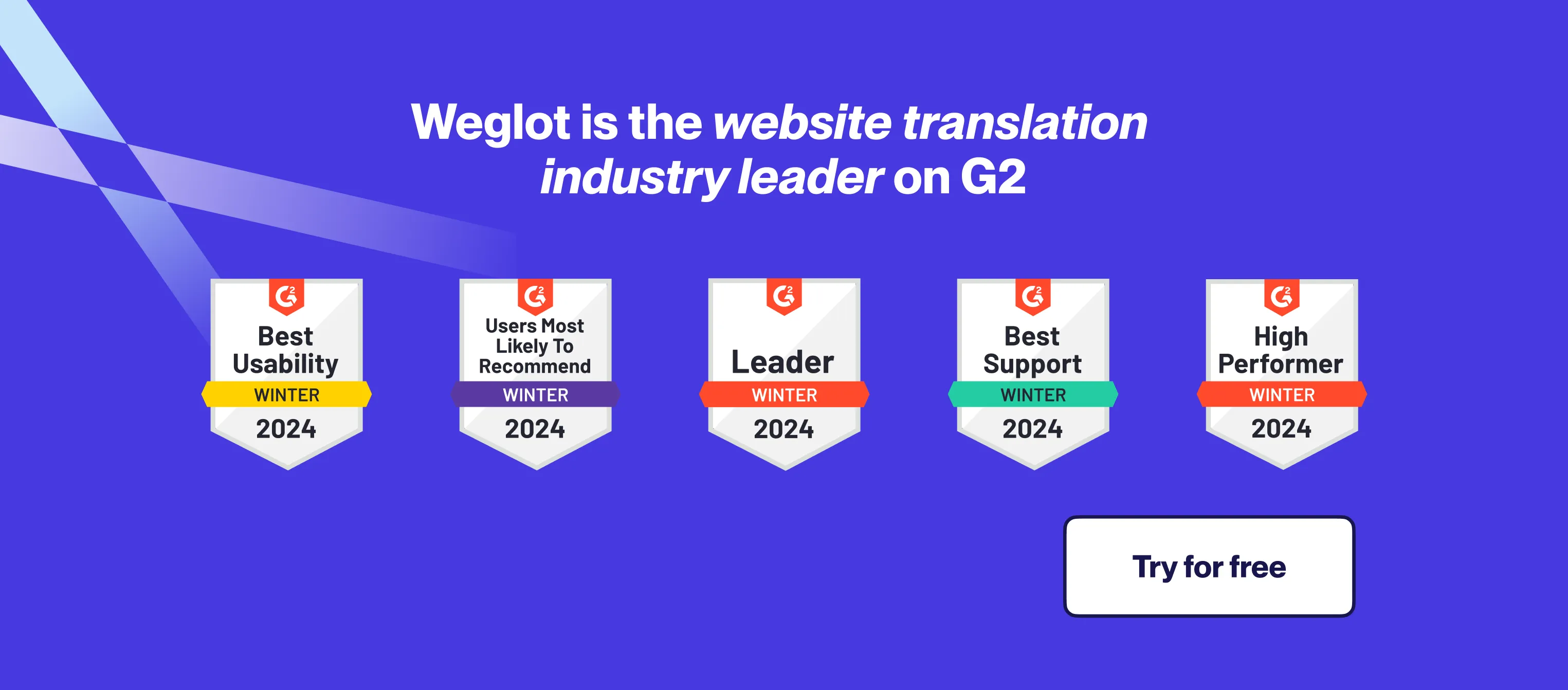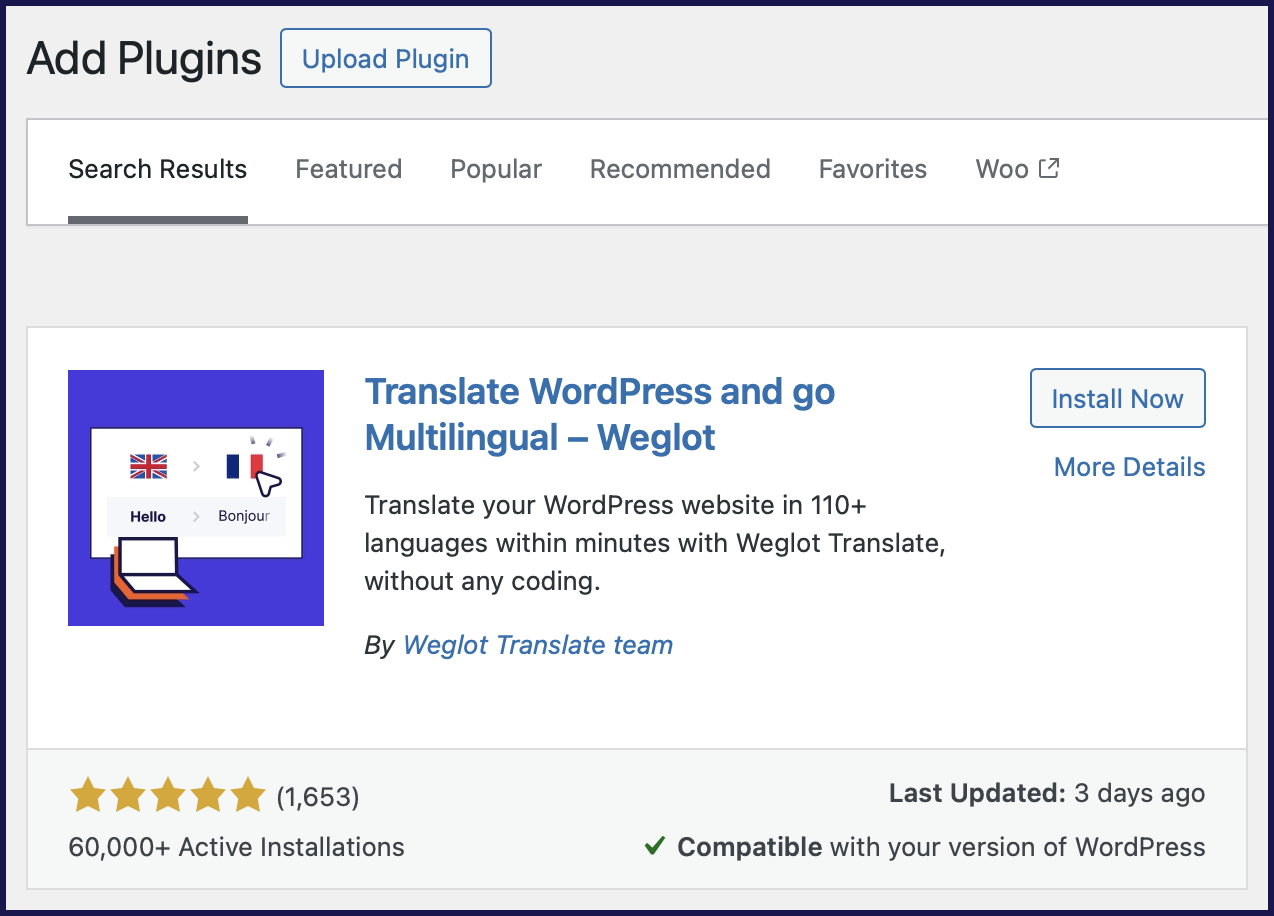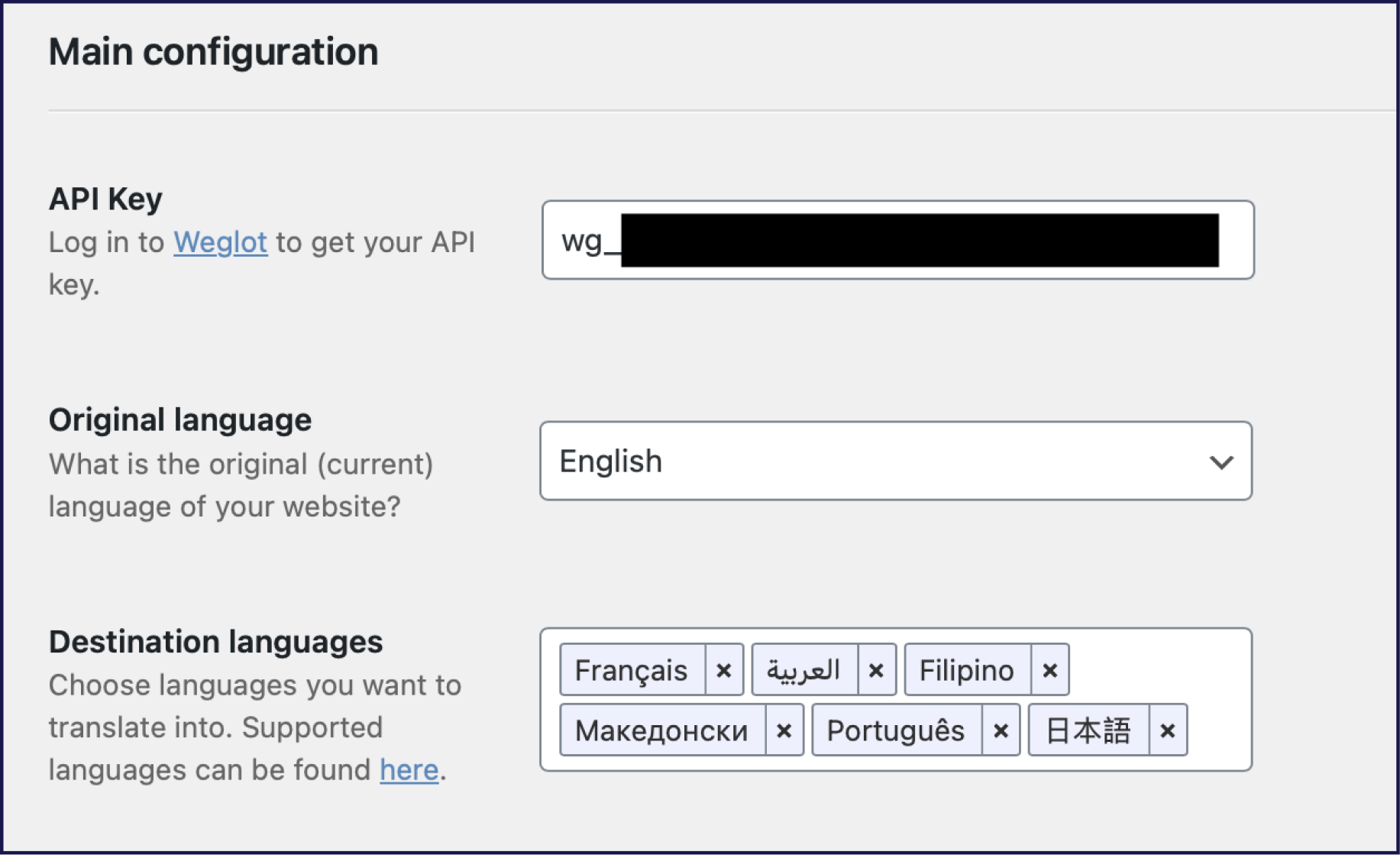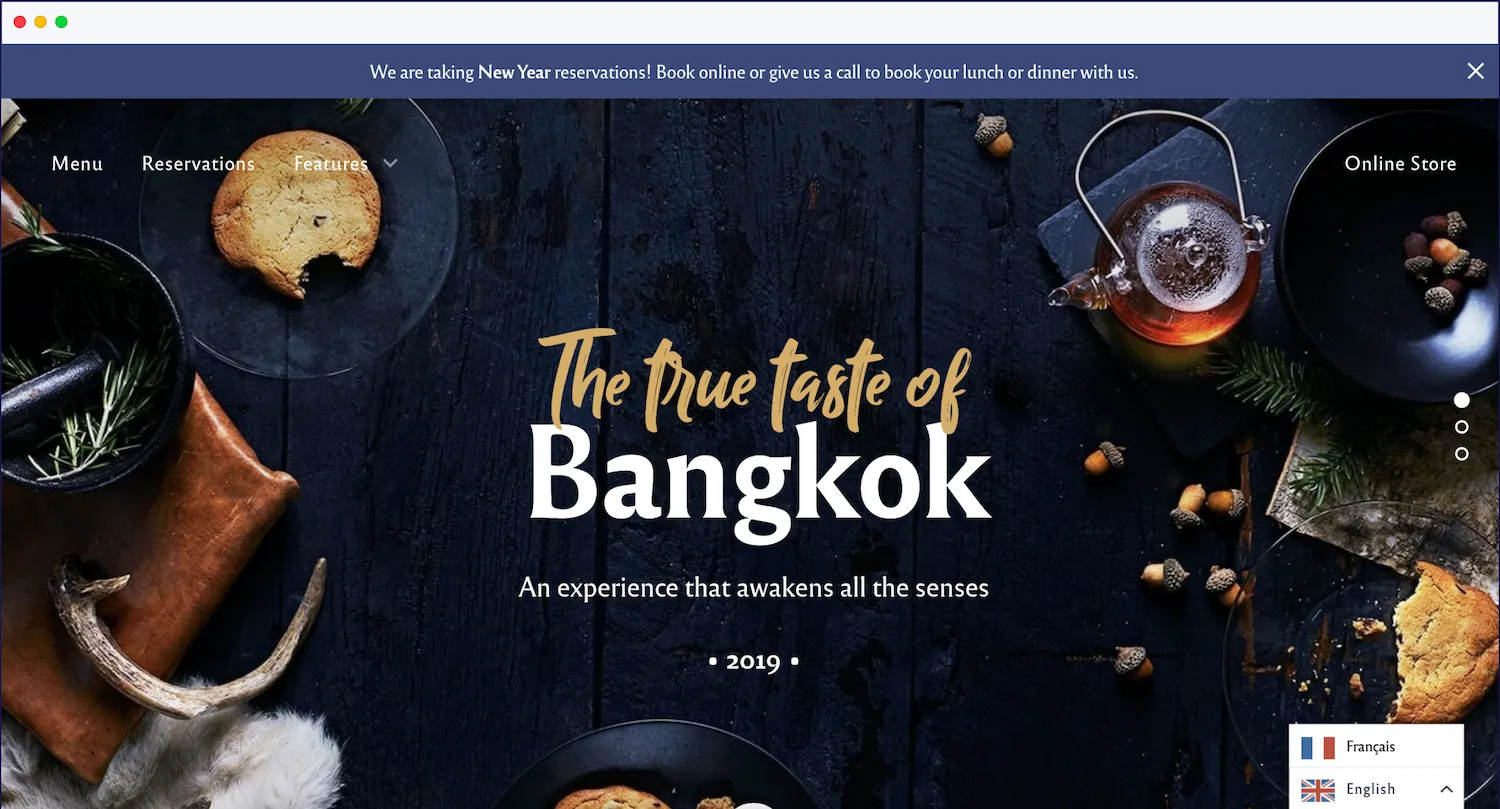
How to Translate Your Entire Website Online: What You Need to Know
Learn how to translate your entire website in a few easy steps using both human and machine translation.

Website localization involves adapting online content to meet the social and cultural preferences of your target market. This allows you to better engage your readers by connecting with them on a more personal level. And the first step to implementing a localization is to translate your entire website.
In this article, we’ll show you how to translate your entire website in a few easy steps. We’ll also cover why website translation is so important for your site, and some basic of the options website visitors have to translate the sites they browse. Buckle up; your website is about to become a multilingual masterpiece!
Why Translate Your Entire Website?
Translating your website is not merely a task you do to check off a box; it’s a strategic initiative that has numerous tangible and intangible benefits. Whether you're a small business looking to expand, a multinational corporation aiming for more seamless global operations, or an eCommerce platform wanting to enter a new foreign market, here’s why translating your website should be on your strategic roadmap:
Reach a Global Audience
By translating your website into different languages, you can expand your global reach. English might be a widely spoken language, but it's not the mother tongue for everyone. Catering to a multilingual audience can widen your customer base significantly.
Improve User Experience
A user is far more likely to engage with your website and make a purchase if the content is presented in their native language. Translation can thus lead to enhanced user experience and increased satisfaction, which in turn can result in higher conversion rates.
Gain Competitive Advantage
In today’s global market, having a multilingual website can set you apart from competitors who only cater to English-speaking audiences. It can be a decisive factor for a potential customer choosing between you and a competitor.
Build Trust and Credibility
Providing content in a person's native language can make your site seem more reliable and credible. This is crucial in industries where trust plays a significant role, like healthcare, finance, or eCommerce.
SEO Benefits
Having your site available in multiple languages can also provide an SEO boost. Search engines will index these multiple versions, making your site more visible to people searching in other languages.
Cultural Relevance
Language is deeply tied to culture, and translation can serve as a stepping stone to localization, which takes into account cultural norms, idioms, and customs. This helps you to internationalize your brand while resonating on a more personal level with your target audience.
Legal Compliance
In some regions, it's legally required to provide information in the native languages of the users. Failing to do so can result in penalties or restrict you from operating in those areas.
Basic Options for Translating a Website
When it comes to translating your website, there are two main options available to you: human translation and machine translation.
Human Translation
Human translation is when professional human translators translate webpages from one language to another. Many agencies provide human translation services in exchange for a fee.
The key benefit of human translation is that it takes the context, structure, and language nuances into account. In addition to this, human translation typically involves procedures like proofreading and quality assurance.
Machine Translation
Machine translation, also called automated translation, translates the content on a page from one language to another using artificial intelligence. Google Translate, for example, uses a neural machine translation system to convert text on a page into other languages.
Unlike human translation, machine translation doesn’t take context or language nuances into account, which often leads to inaccurate translations.

How to Translate a Website With Google Translate
You’re probably most familiar with Google Translate as an option for translating the whole of your website. It lets you translate your entire website into different languages in a few simple steps:

- Launch Google Chrome and go to the Google Translate website i.e. translate.google.com.
- Type the entire URL of your website in the text box on the left.
- Select the new language you wish to translate your website into.
- Click the Translate button.
You should be able to view the translated version of your website from the native language (e.g., English) into a foreign language, and the Translate toolbar on the top lets you quickly change the translation language using the dropdown menu.

However, you may notice that some words and phrases stay untranslated. This happens because Google Translate only translates the actual text on a webpage and ignores any text that appears in an image. The same goes for Google Chrome’s automatic Translate option.
While Google Translate offers a simple and quick way to translate your entire website, it’s not an ideal solution for several reasons. The website translations you get with Google Translate aren’t accurate and the service doesn’t offer any support. In addition to this, Google Translate doesn’t offer human translation.
The good news is that there are other ways to translate your entire website without any of the issues that Google Translate has. Weglot, for example, offers both machine and human translations and comes with support.
Introducing Weglot
Weglot is a complete multilingual solution that lets you automatically translate your entire website into over 110 languages. It uses a combination of Google, Microsoft, and DeepL translation services, depending on the language pair – to deliver the most accurate results.

The Weglot translation solution offers a mix of both human and machine translation. It translates your entire website content using machine translation and then lets you manually edit the automated translations using its in-context editor or translations list – depending on your preference.
.webp)
In summary, Weglot provides:
- Automatic and human translation
- Access to professional website translators
- Translate website content in minutes
- Simple plugin to integrate and easy to use
- Manage entire webpage translations in one place
- Compatible with different website technologies
- SEO optimized
How to Translate Your Entire Website Online Using the Weglot Translation Solution
As the most popular CMS out there, we’ll show you how to translate your entire WordPress website using Weglot.
But, if you’ve used a different CMS or built your site without the help of a CMS you can check out all our integrations here. All our integrations have been created so literally, anyone can add multilingual capabilities to their website – there’s no need for the help of a developer.

Step #1: Install the Weglot Plugin
Search for the Weglot Translate plugin and install and activate it to your WordPress website.

If you haven’t done so already, create a new Weglot account. You’ll need to enter your email address and create a password. Once this is done, you’ll receive a confirmation email to verify your account and get your API key.
Step #2: Configure the Plugin Settings
Go to the Weglot menu item from the WordPress dashboard sidebar menu.

- Enter the API key you received in the API Key box.
- Choose the Original Language i.e. the language (for example, English) your website content is published in using the dropdown menu.
- Set the Destination Languages i.e. the languages you want to translate your website’s content into (for example, Portuguese).
From the same screen, you can configure additional options for language switcher widget style and location based on your preferences.
%20smaller%20size.png)
Additionally, you can also choose to exclude certain pages from being translated or choose to enable auto-detection of visitors’ language based on their web browser settings.

Click the Save button to continue. When you preview your website’s front end, you’ll see the language switcher widget that lets visitors translate your entire website at the click of a button.
Step #3: Create and Manage Your Translations
Weglot automatically generates the first round of machine translation for your entire website. However, you can edit and manage the language translations using Weglot’s built-in editing interfaces.
The Visual Editor offers a live preview of your WordPress website. This allows you to modify your translations as you view them on the webpage while keeping in mind the context and design.

You can edit translations by clicking on the blue pencil icon. This will open a pop-up window that lets you edit the translation.
The Translations List editor provides a side-by-side view of your original content along with machine-generated translations for the chosen language. Any changes made to the translations are automatically saved.

The search bar on the top allows you to quickly find translations and content you would like to modify. You can also click on the Translation options button to set up rules for your translations.
It’s also worth mentioning that Weglot helps you connect with professional translation agencies directly from within the web app as an add-on service. Simply select the pages you want to have professionally translated to get started.
How to Translate a Website Using Web Browser Extensions
If you don’t own or run a site, as a website visitor, navigating a website in a foreign language can be a cumbersome experience. Fortunately, most modern web browsers come with built-in translation features. In this section, we'll guide you through the simple steps to translate a website directly within popular browsers like Google Chrome, Firefox, Safari, and Microsoft Edge.
How To Translate a Website with Google Chrome
Google Chrome is one of the most popular web browsers and comes with a built-in translation feature that can automatically or manually translate a webpage. Here's how you can use this feature on both your desktop browser and Android device:
Automatic Translation
- Open the Website: Navigate to the foreign-language website that you want to translate.
- Translation Prompt: A small pop-up should appear at the top, asking if you'd like to translate the page.
- Select 'Translate': Click the 'Translate' button on the pop-up, and Chrome will automatically translate the webpage to your browser's default language.
Manual Translation
- Open the Website: Navigate to the foreign-language website.
- Right-click: Right-click anywhere on the page.
- Select 'Translate': Choose the 'Translate to [Your Language]' option from the context menu.
- Confirm Translation: Chrome will then translate the webpage to your chosen language.
Settings Adjustment
- Customize Languages: If you'd like to change the target language, click on the three vertical dots next to the translated language at the top and select a different language from the dropdown list.
- Always Translate: If you regularly visit websites in a specific language, you can select 'Always translate' to have Chrome automatically translate websites in that language in the future.
How To Translate a Website with Firefox
Firefox doesn't have a built-in translation feature like Google Chrome, but it offers robust support for extensions that can easily handle website translation. One popular extension for this purpose is To Google Translate. Here's a step-by-step guide on how to use it:
Installing the Extension
- Open Firefox: Launch your Firefox browser.
- Go to Add-ons: Click on the menu button (three horizontal lines) in the top-right corner and select "Add-ons."
- Search for 'To Google Translate': In the search bar, type "To Google Translate" and hit Enter.
- Install the Extension: Click the "Add to Firefox" button next to the extension. Confirm the installation if prompted.
Translating a Website
- Navigate to Website: Open the website you wish to translate.
- Highlight Text: Highlight the text you want to translate. For the entire webpage, you might need to scroll down to ensure all text is loaded and then highlight.
- Right-click for Options: Right-click on the highlighted text.
- Select 'Translate': From the context menu, choose "Translate selection" to translate the highlighted text.
Using Extension Icon
- Click on Extension Icon: After installing the extension, you'll notice a Google Translate icon in your toolbar.
- Translate Page: Click this icon when on a foreign-language webpage. A new tab will open with the translated content.
How To Translate a Website with Safari
For Mac users, Safari offers a simple and intuitive way to translate web pages, although the feature is currently limited to a few languages and available only on macOS Big Sur or later. Here's how you can translate a website in Safari using either your Mac or iPhone:
Enabling Translation
- Open Safari: Launch your Safari browser.
- Navigate to Website: Visit the foreign-language website you wish to translate.
- Click on Translate Icon: On the address bar, you'll find a translate icon that looks like two 'A's next to each other. Click on it.
- Select Language: Choose the language you want to translate the webpage into.
Manual Translation
- Right-click: If automatic translation doesn't kick in or if you want to translate specific text, you can highlight the text, right-click, and then select "Translate."
Review Translation
- Translation Toolbar: Once translated, a toolbar will appear at the top, showing the original and translated languages.
- Switch Back: If you wish to revert back to the original language, you can click "View Original" in the translation toolbar.
Settings Adjustment
Preferences: If you want to customize translation settings, you can go to Safari > Preferences > Websites > Page Translation to enable or disable automatic translation for specific websites or languages.
How To Translate a Website with Microsoft Edge
Microsoft Edge, based on the Chromium engine, comes with a built-in translation feature that's both convenient and straightforward to use. This guide will walk you through the process of translating a website in Edge:
Automatic Translation
- Open Microsoft Edge: Launch your Edge browser.
- Navigate to Website: Visit the website you want to translate.
- Translation Prompt: A pop-up will appear at the top of the page asking if you'd like to translate it.
- Select 'Yes': Click on 'Yes' to translate the page into your browser's default language.
Manual Translation
- Right-Click: On the webpage, right-click anywhere.
- Choose 'Translate': Select the "Translate" option from the context menu.
- Confirm Translation: The page will then be translated to your browser's default language.
Changing the Target Language
- Translation Bar: After translation, a bar will appear at the top showing the original and translated languages.
- Change Language: Click on the language dropdown to select a different target language if needed.
Translation Settings
- Customize Settings: You can customize translation preferences by clicking on the three horizontal dots in the translation bar and selecting "Translation options."
- Automatic Translation: From the settings, you can choose to always translate web pages from a specific language.
How to Translate a Website Using Android and iOS Mobile Devices
Navigating through a webpage written in a foreign language can be a daunting task. Luckily, popular mobile browsers like Google Chrome and Safari offer built-in translation features that can convert the text into a language of your choice.
Here's a detailed step-by-step guide on how to utilize these features on both Android and iOS devices.
Using Google Chrome to Translate Webpages
- Open Chrome: Tap the Chrome app on your device.
- Visit the Webpage: Navigate to a webpage written in a foreign language.
- Translation Notification: A notification should pop up at the top of the screen, suggesting translation.
- Choose Language: Tap on the language into which you want the page translated.
- Change Default Language (if required):
a. Tap on "Settings."
b. Navigate to "More languages" and select your preferred language. - Always Translate:
- a. Return to "Settings."
b. Choose "Always translate pages in [selected language]."
Translating Webpages in Safari
- Launch Safari: Open the Safari browser on your device.
- Navigate to Webpage: Visit the webpage that is in a language different from your preferred one.
- Translation Icon: In the address bar, you'll observe an icon resembling two 'A's or a translate icon, depending on your iOS version. Tap it.
- Choose Translation Language: Select the language into which you wish to have the webpage translated.
- Read the Translated Page: The website should now display the content in the chosen language, making it comprehensible
Sometimes, a webpage may not trigger the translation notification in Chrome, or the translation icon might be absent in Safari. This could be due to various reasons like website settings or browser compatibility issues. Always ensure that your browser is updated to the latest version to access all the available features and ensure smooth functionality.
Ready to Go Multilingual? What to Do Next
Translating your website isn't just a cosmetic change; it's a strategic investment with the potential for substantial returns. Whether you're a burgeoning small business or a well-established global brand, a multilingual website opens doors to diverse markets, elevates user experience, and gives you a competitive edge.
For this, you’ll need a user-friendly translation tool like Weglot that lets you translate your entire website into different target languages. Tools like Weglot make the process easier and more effective, offering both machine and human translation to ensure the nuanced accuracy that resonates with your target audience.
So, if you're seeking to cultivate a global presence and create a more inclusive, user-friendly experience, it’s time to put website translation on your strategic roadmap by choosing a Weglot plan that suits your needs.













